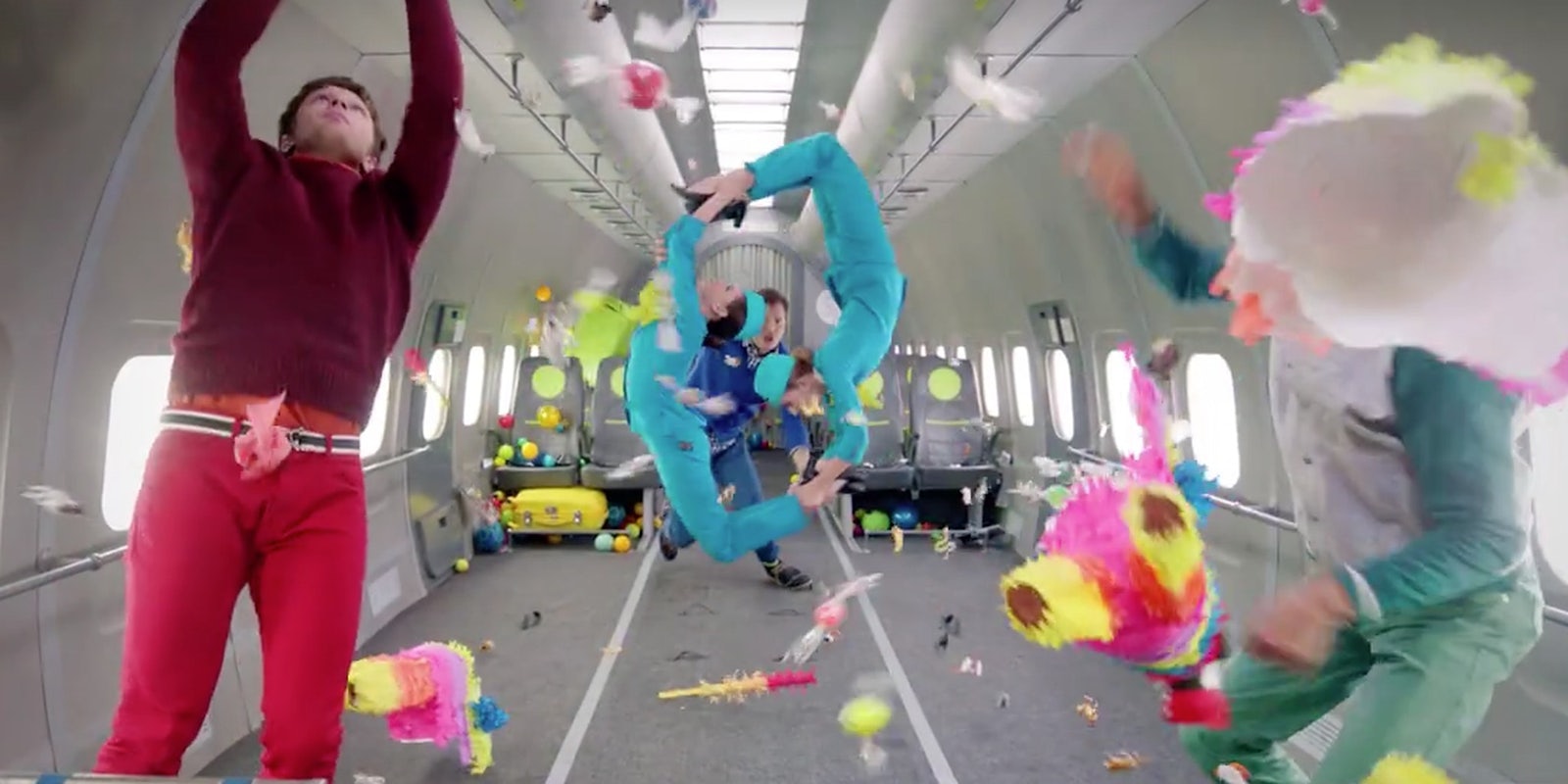In case you missed it, OK Go’s latest in a long line of ambitious music videos takes place in “Zero Gravity.”
To shoot the video, the band hopped aboard a special fixed-wing airplane, lovingly dubbed the “vomit comet” by astronauts in training thanks to its ability to induce, well, vomiting. The plane, provided and operated by the company S7, climbs higher than a commercial jet and then the pilot begins to take it on a parabolic flight pattern. In other words, the plane goes up at a steep angle, then back down again, creating 25 seconds of weightlessness for the cargo (i.e. OK Go and crew).
While the cargo is still under Earth’s gravitational force, they feel weightless. During the parabolic arc and shielded from air resistance within the confines of the plane cabin there is no force pushing against the body. When you’re on the ground, by contrast, the weight of your body pushes against the ground and the ground pushes back up against you. The sensation is also not the same as skydivers, because sky divers feel the friction of the air passing by as they fall through it.
But in between the climb, apex, and descent of each parabola is a brief period of hypergravity as the plane throws them into the air and catches them again. In this time, the cargo experience even higher gravitational force, throwing them downward. If you look closely, you can see these moments where the band and dancers will hold tightly onto guard rails or be seemingly plunged back into their seats.
According to the band’s website, OK Go compensated for the five minutes of normal gravity in between the parabolic maneuvers by pausing the song in production, and cutting the video together.
The longest period of weightlessness that it is possible to achieve in these circumstances is about 27 seconds, and after each period of weightlessness, it takes about five minutes for the plane to recover and prepare for then [sic] next round. Because we wanted the video to be a single, uninterrupted routine, we shot continuously over the course of 8 consecutive weightless periods, which took about 45 minutes, total. We paused our actions, and the music, during the non-weightless periods, and then cut out these sections and smoothed over each transition with a morph.
You can spot the moments in the video when we skip ahead in time because they are points when gravity briefly returns. This happens at 0:46, 1:06, 1:27, 1:48, 2:09, 2:30, and 2:50.
When these planes aren’t used for shooting amazing music videos, they’re used to train astronauts in zero gravity.
According to science writer Mary Roach in Packing for Mars, parabolic flight was first dreamed up in the 1950s when researchers still weren’t sure what would become of man in a low-gravity environment. Scientists weren’t entirely positive that simple bodily functions like keeping blood flowing in the right directions truly relied on gravity or not. After all, everything we knew up until then about human physiology was all in the context of developing, living, and dying under the constraints of Earth’s gravity.
But once they knew humans could live in low gravity, the planes became the venues for various related experiments. Things like eating and defecating have all been tested out on these flights first.
Unfortunately, our sense of position and balance on Earth is pretty dependent on gravity. Our brains know whether we’re sitting, standing, lying down, or in motion based on a variety of cues we receive from our eyes, muscles, joints, and inner ears (a.k.a. the vestibular system), according to the Vestibular Disorders Association. Signals from the inner ear are particularly reliant on gravity because our vestibular system sends messages to the brain based on the position of fluids in the inner ear. Without the influence of gravity, those fluids don’t behave the way they should and send confusing signals to the brain. This can essentially cause the body to “panic,” in the words of former Reduced Gravity Research Program director John Yaniec, and lead to a vomiting response. Roughly two-thirds of all people will experience some form of illness during space flight, ranging from “moderate” to “violent.”
For her book, Roach also got onto one of these vomit comets. Thankfully she didn’t get sick, and instead described the sensation of weightlessness like this:
You never think about the weight of your organs inside you. On Earth, your heart is a half-pound clapper hanging off the end of your aorta. Your arms burden your shoulders like buckets on a yoke. The colon uses the uterus as a beanbag chair. Even the weight of your hair imparts a sensation on your scalp. In weightlessness, all this disappears. Your organs float inside your torso. The result is a subtle physical euphoria, an indescribable sense of being freed from something you did not realize was there.
For those of us on terra firma, we might just have to bum off of Roach’s and OK Go’s trip.
Screengrab via OK Go/Facebook
